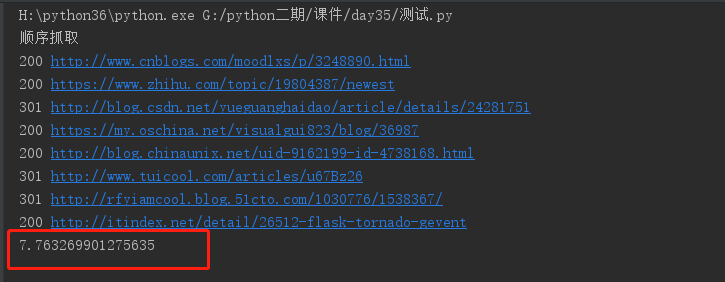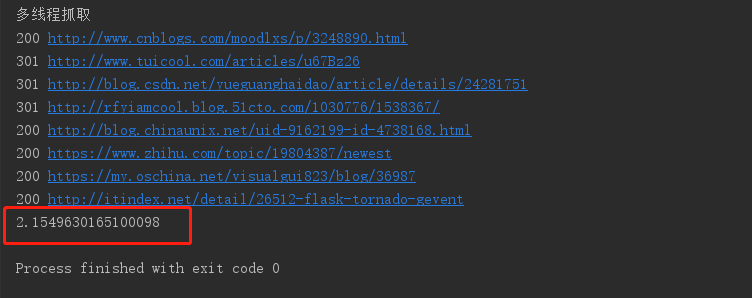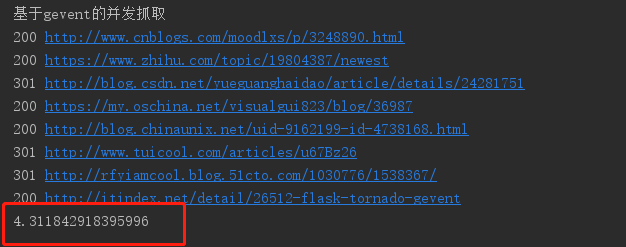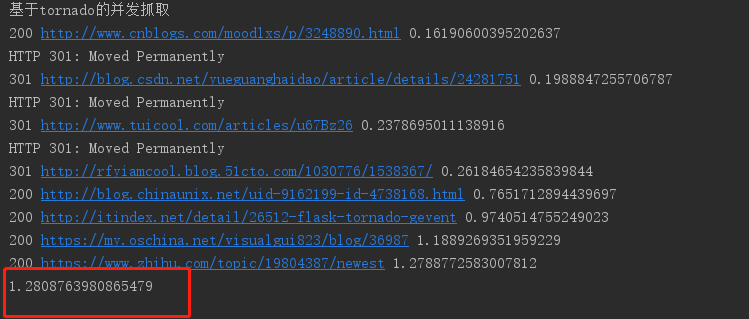利用Python怎么样实现一个并发爬虫?很多新手对此不是很清楚,为了帮助大家解决这个难题,下面小编将为大家详细讲解,有这方面需求的人可以来学习下,希望你能有所收获。
一.顺序抓取
顺序抓取是最最常见的抓取方式,一般初学爬虫的朋友就是利用这种方式,下面是一个测试代码,顺序抓取8个url,我们可以来测试一下抓取完成需要多少时间:
HEADERS = {'Accept': 'text/html,application/xhtml+xml,application/xml;q=0.9',
'Accept-Language': 'zh-CN,zh;q=0.8',
'Accept-Encoding': 'gzip, deflate',}
URLS = ['http://www.cnblogs.com/moodlxs/p/3248890.html',
'https://www.zhihu.com/topic/19804387/newest',
'http://blog.csdn.net/yueguanghaidao/article/details/24281751',
'https://my.oschina.net/visualgui823/blog/36987',
'http://blog.chinaunix.net/uid-9162199-id-4738168.html',
'http://www.tuicool.com/articles/u67Bz26',
'http://rfyiamcool.blog.51cto.com/1030776/1538367/',
'http://itindex.net/detail/26512-flask-tornado-gevent']
#url为随机获取的一批url
def func():
"""
顺序抓取
"""
import requests
import time
urls = URLS
headers = HEADERS
headers['user-agent'] = "Mozilla/5.0+(Windows+NT+6.2;+WOW64)+AppleWebKit/537" \
".36+(KHTML,+like+Gecko)+Chrome/45.0.2454.101+Safari/537.36"
print(u'顺序抓取')
starttime= time.time()
for url in urls:
try:
r = requests.get(url, allow_redirects=False, timeout=2.0, headers=headers)
except:
pass
else:
print(r.status_code, r.url)
endtime=time.time()
print(endtime-starttime)
func() 我们直接采用内建的time.time()来计时,较为粗略,但可以反映大概的情况。下面是顺序抓取的结果计时:

可以从图片中看到,显示的顺序与urls的顺序是一模一样的,总共耗时为7.763269901275635秒,一共8个url,平均抓取一个大概需要0.97秒。总体来看,还可以接受。
二.多线程抓取
线程是python内的一种较为不错的并发方式,我们也给出相应的代码,并且为每个url创建了一个线程,一共8线程并发抓取,下面的代码:
下面是我们运行8线程的测试代码:
HEADERS = {'Accept': 'text/html,application/xhtml+xml,application/xml;q=0.9',
'Accept-Language': 'zh-CN,zh;q=0.8',
'Accept-Encoding': 'gzip, deflate',}
URLS = ['http://www.cnblogs.com/moodlxs/p/3248890.html',
'https://www.zhihu.com/topic/19804387/newest',
'http://blog.csdn.net/yueguanghaidao/article/details/24281751',
'https://my.oschina.net/visualgui823/blog/36987',
'http://blog.chinaunix.net/uid-9162199-id-4738168.html',
'http://www.tuicool.com/articles/u67Bz26',
'http://rfyiamcool.blog.51cto.com/1030776/1538367/',
'http://itindex.net/detail/26512-flask-tornado-gevent']
def thread():
from threading import Thread
import requests
import time
urls = URLS
headers = HEADERS
headers['user-agent'] = "Mozilla/5.0+(Windows+NT+6.2;+WOW64)+AppleWebKit/537.36+" \
"(KHTML,+like+Gecko)+Chrome/45.0.2454.101+Safari/537.36"
def get(url):
try:
r = requests.get(url, allow_redirects=False, timeout=2.0, headers=headers)
except:
pass
else:
print(r.status_code, r.url)
print(u'多线程抓取')
ts = [Thread(target=get, args=(url,)) for url in urls]
starttime= time.time()
for t in ts:
t.start()
for t in ts:
t.join()
endtime=time.time()
print(endtime-starttime)
thread()多线程抓住的时间如下:

可以看到相较于顺序抓取,8线程的抓取效率明显上升了3倍多,全部完成只消耗了2.154秒。可以看到显示的结果已经不是urls的顺序了,说明每个url各自完成的时间都是不一样的。线程就是在一个进程中不断的切换,让每个线程各自运行一会,这对于网络io来说,性能是非常高的。但是线程之间的切换是挺浪费资源的。
三.gevent并发抓取
gevent是一种轻量级的协程,可用它来代替线程,而且,他是在一个线程中运行,机器资源的损耗比线程低很多。如果遇到了网络io阻塞,会马上切换到另一个程序中去运行,不断的轮询,来降低抓取的时间
下面是测试代码:
HEADERS = {'Accept': 'text/html,application/xhtml+xml,application/xml;q=0.9',
'Accept-Language': 'zh-CN,zh;q=0.8',
'Accept-Encoding': 'gzip, deflate',}
URLS = ['http://www.cnblogs.com/moodlxs/p/3248890.html',
'https://www.zhihu.com/topic/19804387/newest',
'http://blog.csdn.net/yueguanghaidao/article/details/24281751',
'https://my.oschina.net/visualgui823/blog/36987',
'http://blog.chinaunix.net/uid-9162199-id-4738168.html',
'http://www.tuicool.com/articles/u67Bz26',
'http://rfyiamcool.blog.51cto.com/1030776/1538367/',
'http://itindex.net/detail/26512-flask-tornado-gevent']
def main():
"""
gevent并发抓取
"""
import requests
import gevent
import time
headers = HEADERS
headers['user-agent'] = "Mozilla/5.0+(Windows+NT+6.2;+WOW64)+AppleWebKit/537.36+" \
"(KHTML,+like+Gecko)+Chrome/45.0.2454.101+Safari/537.36"
urls = URLS
def get(url):
try:
r = requests.get(url, allow_redirects=False, timeout=2.0, headers=headers)
except:
pass
else:
print(r.status_code, r.url)
print(u'基于gevent的并发抓取')
starttime= time.time()
g = [gevent.spawn(get, url) for url in urls]
gevent.joinall(g)
endtime=time.time()
print(endtime - starttime)
main()协程的抓取时间如下:

正常情况下,gevent的并发抓取与多线程的消耗时间差不了多少,但是可能是我网络的原因,或者机器的性能的原因,时间有点长......,请各位小主在自己电脑进行跑一下看运行时间
四.基于tornado的coroutine并发抓取
tornado中的coroutine是python中真正意义上的协程,与python3中的asyncio几乎是完全一样的,而且两者之间的future是可以相互转换的,tornado中有与asyncio相兼容的接口。
下面是利用tornado中的coroutine进行并发抓取的代码:
利用coroutine编写并发略显复杂,但这是推荐的写法,如果你使用的是python3,强烈建议你使用coroutine来编写并发抓取。
下面是测试代码:
HEADERS = {'Accept': 'text/html,application/xhtml+xml,application/xml;q=0.9',
'Accept-Language': 'zh-CN,zh;q=0.8',
'Accept-Encoding': 'gzip, deflate',}
URLS = ['http://www.cnblogs.com/moodlxs/p/3248890.html',
'https://www.zhihu.com/topic/19804387/newest',
'http://blog.csdn.net/yueguanghaidao/article/details/24281751',
'https://my.oschina.net/visualgui823/blog/36987',
'http://blog.chinaunix.net/uid-9162199-id-4738168.html',
'http://www.tuicool.com/articles/u67Bz26',
'http://rfyiamcool.blog.51cto.com/1030776/1538367/',
'http://itindex.net/detail/26512-flask-tornado-gevent']
import time
from tornado.gen import coroutine
from tornado.ioloop import IOLoop
from tornado.httpclient import AsyncHTTPClient, HTTPError
from tornado.httpclient import HTTPRequest
#urls与前面相同
class MyClass(object):
def __init__(self):
#AsyncHTTPClient.configure("tornado.curl_httpclient.CurlAsyncHTTPClient")
self.http = AsyncHTTPClient()
@coroutine
def get(self, url):
#tornado会自动在请求首部带上host首部
request = HTTPRequest(url=url,
method='GET',
headers=HEADERS,
connect_timeout=2.0,
request_timeout=2.0,
follow_redirects=False,
max_redirects=False,
user_agent="Mozilla/5.0+(Windows+NT+6.2;+WOW64)+AppleWebKit/537.36+\
(KHTML,+like+Gecko)+Chrome/45.0.2454.101+Safari/537.36",)
yield self.http.fetch(request, callback=self.find, raise_error=False)
def find(self, response):
if response.error:
print(response.error)
print(response.code, response.effective_url, response.request_time)
class Download(object):
def __init__(self):
self.a = MyClass()
self.urls = URLS
@coroutine
def d(self):
print(u'基于tornado的并发抓取')
starttime = time.time()
yield [self.a.get(url) for url in self.urls]
endtime=time.time()
print(endtime-starttime)
if __name__ == '__main__':
dd = Download()
loop = IOLoop.current()
loop.run_sync(dd.d)抓取的时间如下:

可以看到总共花费了128087秒,而这所花费的时间恰恰就是最后一个url抓取所需要的时间,tornado中自带了查看每个请求的相应时间。我们可以从图中看到,最后一个url抓取总共花了1.28087秒,相较于其他时间大大的增加,这也是导致我们消耗时间过长的原因。那可以推断出,前面的并发抓取,也在这个url上花费了较多的时间。
看完上述内容是否对您有帮助呢?如果还想对相关知识有进一步的了解或阅读更多相关文章,请关注亿速云行业资讯频道,感谢您对亿速云的支持。
亿速云「云服务器」,即开即用、新一代英特尔至强铂金CPU、三副本存储NVMe SSD云盘,价格低至29元/月。点击查看>>
免责声明:本站发布的内容(图片、视频和文字)以原创、转载和分享为主,文章观点不代表本网站立场,如果涉及侵权请联系站长邮箱:is@yisu.com进行举报,并提供相关证据,一经查实,将立刻删除涉嫌侵权内容。